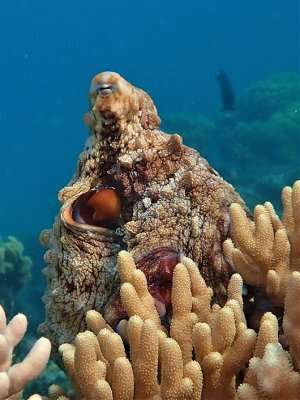Previous 1 ... 47 48 49 50 51 52 53 ... 75 Next

The unique brainpower of octopuses—known for their intelligence and Houdini-like escapes—has been revealed by University of Queensland researchers.
Dr. Wen-Sung Chung from UQ's Queensland Brain Institute is part of a team that studied four octopus species using MRI techniques to produce detailed 3D images for comparing their unique brain structures.
He said octopus brains varied, depending on where a species lived, when it was active and if it interacted with other animals.
"The octopus is a master of camouflage, capable of solving complex tasks and their cognitive ability is said to approach that of some small mammals," Dr. Chung said.
"We investigated four species, including one deep-sea octopus, one solitary nocturnal species and two different reef dwellers active during daylight."
Dr. Chung said the octopus found in deep waters had a smooth brain like marsupials and rodents, suited for its slow pace of life and limited interactions with other animals.
The reef octopuses had a significantly larger brain with some properties similar to primates, adapted for complex visual tasks and social interaction in a busy, well-lit environment.
"These octopuses have some remarkably complex behaviors not known in other octopuses," Dr. Chung said.
https://phys.org/news/2021-11-smart-octopus.html
Did they forget the one solitary nocturnal species?
Founded in 1930, Chicago's Shedd Aquarium is not just a popular tourist attraction. Its staff also aids in worldwide conservation efforts and conducts essential research on animal health and behavior, nutrition, genetics, aquatic filtration, and molecular and microbial ecology. Over the last four years, those staffers have been puzzled by the mysterious disappearance of an antiparasitic drug routinely added to the water in the aquarium's quarantine habitat. Now, with the help of microbiologists at Northwestern University, they've cracked the case. The culprits: some 21 members of a family of microbes who were munching regularly on the medicine in the water, according to a recent paper published in the journal Science of the Total Environment.
The aquarium's Center for Conservation and Research includes an Animal Care and Science Division, with a state-of-the-art animal hospital for monitoring the health of all the animals in the exhibits and treating them as necessary. (If you want to know how to give an electric eel an MRI, the center's team has you covered.)
Since 2015, the center has been working on a special research project investigating aquarium microbiomes. Among other topics, the project involves studying microbial communities in aquarium bio-filters. Such closed aquatic systems can quickly become toxic, thanks to ammonia waste from the fish, and certain microbial communities can help keep those levels in check. But other microbes are less beneficial, as evidenced by the Case of the Missing Chloroquine.
Whenever the Shedd Aquarium acquires new animals, the creatures are first placed in the quarantine habitat to prevent them introducing any outside pathogens into the aquarium's carefully controlled environment. Part of that process involves administrating chloroquine phosphate, usually by adding it to the habitat's water. Staffers regularly monitor the chloroquine concentrations, which is how they noticed that those concentrations were usually much lower than expected—often too low to serve as an effective antiparasitic.
Enter co-author Erica M. Hartmann and her fellow microbial detectives from Northwestern University. They took samples of the quarantine habitat's water, as well as swab samples from the walls and pipes of the habitat. They brought the samples back to their lab for extensive analysis. All told, they counted some 754 different microbes that called the habitat home, and the team quickly surmised that the chloroquine thief was among them.
https://arstechnica.com/science/2021/11 ... medicines/
A cure for Type 1 diabetes? For one man, it seems to have worked
https://www.seattletimes.com/nation-wor ... ve-worked/
https://www.seattletimes.com/nation-wor ... ve-worked/
Wow, but that is quite a positive article. It will be interesting to see how other participants fare with this treatment.
The international Forward Search Experiment team, led by physicists at the University of California, Irvine, has achieved the first-ever detection of neutrino candidates produced by the Large Hadron Collider at the CERN facility near Geneva, Switzerland.
In a paper published today in the journal Physical Review D, the researchers describe how they observed six neutrino interactions during a pilot run of a compact emulsion detector installed at the LHC in 2018.
"Prior to this project, no sign of neutrinos has ever been seen at a particle collider," said co-author Jonathan Feng, UCI Distinguished Professor of physics & astronomy and co-leader of the FASER Collaboration. "This significant breakthrough is a step toward developing a deeper understanding of these elusive particles and the role they play in the universe."
He said the discovery made during the pilot gave his team two crucial pieces of information.
"First, it verified that the position forward of the ATLAS interaction point at the LHC is the right location for detecting collider neutrinos," Feng said. "Second, our efforts demonstrated the effectiveness of using an emulsion detector to observe these kinds of neutrino interactions."
The pilot instrument was made up of lead and tungsten plates alternated with layers of emulsion. During particle collisions at the LHC, some of the neutrinos produced smash into nuclei in the dense metals, creating particles that travel through the emulsion layers and create marks that are visible following processing. These etchings provide clues about the energies of the particles, their flavors—tau, muon or electron—and whether they're neutrinos or antineutrinos.
https://phys.org/news/2021-11-physicist ... lider.html
This is exactly why Science Reporters need to firstly be able to understand Science.
World's first living robots can now reproduce, scientists say
Interesting research, but no, we don’t have living, reproducing robots
So, of course, CNN headlined its coverage "World's first living robots can now reproduce."
This is a case when something genuinely interesting is going on, but both the scientists and some of the coverage of the developments are promoting it as far more than it actually is. So, let's take a look at what has really been done.
Princeton team disables long-targeted gene behind spread of major cancers
For the first time, computer scientists and mathematicians have used artificial intelligence to help prove or suggest new mathematical theorems in the complex fields of knot theory and representation theory.
The astonishing results have been published today in the pre-eminent scientific journal, Nature.
Professor Geordie Williamson is Director of the University of Sydney Mathematical Research Institute and one of the world's foremost mathematicians. As a co-author of the paper, he applied the power of Deep Mind's AI processes to explore conjectures in his field of speciality, representation theory.
His co-authors were from DeepMind—the team of computer scientists behind AlphaGo, the first computer program to successfully defeat a world champion in the game of Go in 2016.
Professor Williamson said: "Problems in mathematics are widely regarded as some of the most intellectually challenging problems out there.
"While mathematicians have used machine learning to assist in the analysis of complex data sets, this is the first time we have used computers to help us formulate conjectures or suggest possible lines of attack for unproven ideas in mathematics."
https://phys.org/news/2021-12-maths-hai ... icial.html

Detecting light beyond the visible red range of our eyes is hard to do, because infrared light carries so little energy compared to ambient heat at room temperature. This obscures infrared light unless specialized detectors are chilled to very low temperatures, which is both expensive and energy-intensive.
Now researchers led by the University of Cambridge have demonstrated a new concept in detecting infrared light, showing how to convert it into visible light, which is easily detected.
In collaboration with colleagues from the UK, Spain and Belgium, the team used a single layer of molecules to absorb the mid-infrared light inside their vibrating chemical bonds. These shaking molecules can donate their energy to visible light that they encounter, 'upconverting' it to emissions closer to the blue end of the spectrum, which can then be detected by modern visible-light cameras.
The results, reported in the journal Science, open up new low-cost ways to sense contaminants, track cancers, check gas mixtures, and remotely sense the outer universe.
The challenge faced by the researchers was to make sure the quaking molecules met the visible light quickly enough. "This meant we had to trap light really tightly around the molecules, by squeezing it into crevices surrounded by gold," said first author Angelos Xomalis from Cambridge's Cavendish Laboratory.
The researchers devised a way to sandwich single molecular layers between a mirror and tiny chunks of gold, only possible with 'meta-materials' that can twist and squeeze light into volumes a billion times smaller than a human hair.
https://phys.org/news/2021-12-color-cha ... rared.html
Scientists Developed a Questionnaire to Identify Whether Your Cat Is a Psychopath
I didn't even think this would be a question. It should read 'how much of a psychopath' not 'whether'.
DARPA Funded Researchers Accidentally Discover The World’s First Warp Bubble
I wrote the book on warp drive. No, we didn’t accidentally create a warp bubble.
A little history on Miguel Alcubierres' equations on Warp Drive. The equations make sense mathematically. But they are not in line with physical reality. A lot of others have posted papers exploring those equations, and those all check out mathematically.
The problem with all of them however is that they all describe a way to move something with mass at the speed of light, but all of them require the mass to already be moving at the speed of light. None of them describe how to get that mass up to the speed of light, only how to keep it there.
So if you ever see "we created warp drive!" in a title again, you know it's likely clickbait. ![]()
Previous 1 ... 47 48 49 50 51 52 53 ... 75 Next